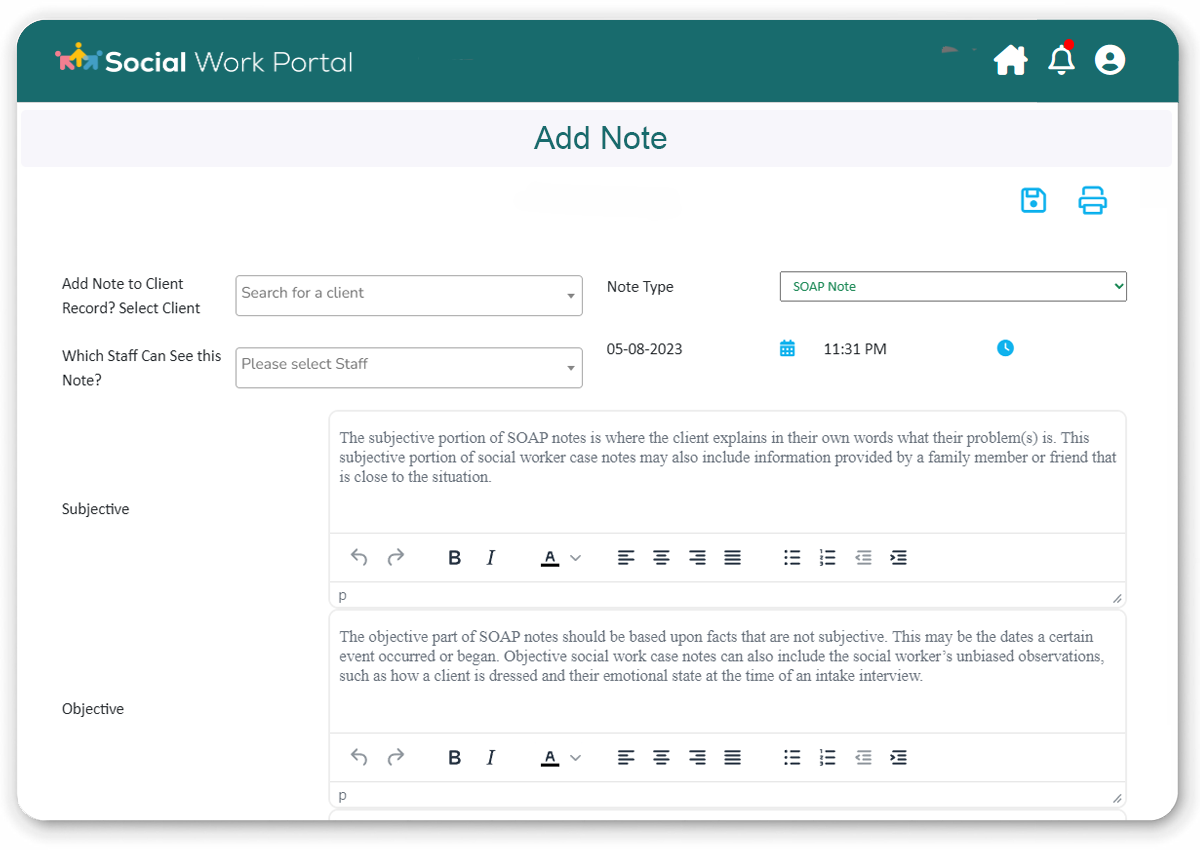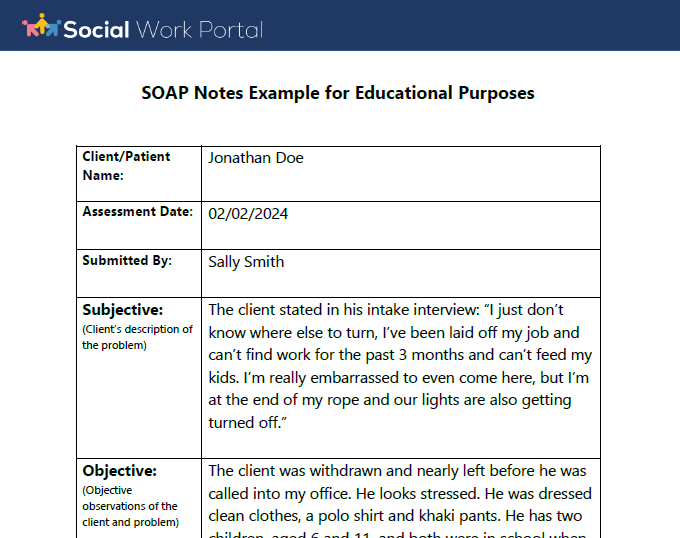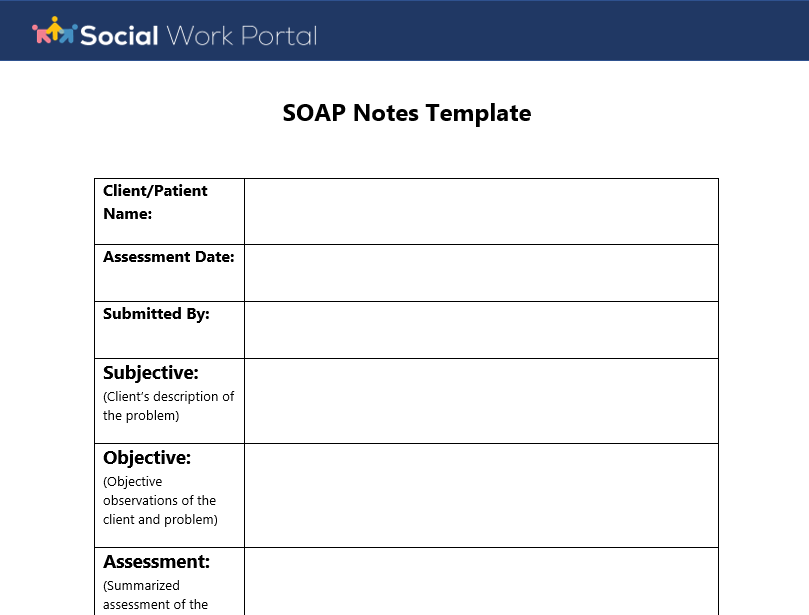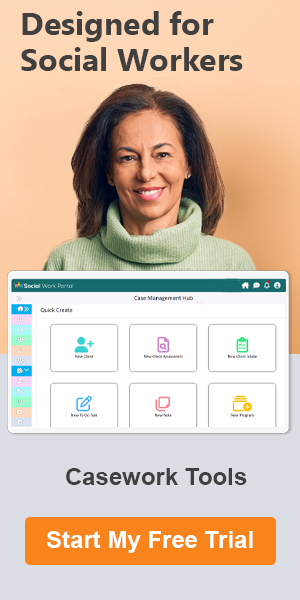2024 Social Work Guide | The Different Types & Stages of Social Work Processes
Best Social Work Process for Social Workers | Different Process Types & Social Work Notes Documentation Examples
Social workers have many different types of tasks in the normal course of their work helping people. The social work process that a professional uses provides an important structure to those tasks.
This simple (but detailed) guide for social workers will cover several social work processes and how they work. The more processes a social worker knows, the better they’ll be able to handle any type of client or situation.
In addition to providing social work process descriptions, this article will also cover the best way to document a process report in social work using the SOAP method for social worker case notes.

Social Work Helping Process & Other Social Work Processes


See Also: What You Need to Know About the HIPAA Form
Table of Contents
In this article, you can expect to find details on the following topics. Keep on scrolling down this page to read each section, or click any link below to go directly to that section.
- What Are Social Work Processes? What Does a Social Work Process Really Involve?
- Social Work Helping Process (The Three Main Stages)
- Task-Centered Practice (TCP) Social Work Process
- Solution-Focused Brief Therapy (SFBT) Social Case Work Process
- Narrative Engagement Process in Social Work
- Cognitive-Behavioral Therapy Social Work Process
- Planned Change Process in Social Work
- Problem Solving Process in Social Work
- Where Can You Find a Step-by-Step Social Case Work Process With Sample Tasks?
- Social Work Intervention Process for Crisis Management
- Social Work Assessment & Planning Process and Tools
- What Are SOAP Notes Social Work Professionals Use?
- Free SOAP Notes Examples for Social Workers – Downloadable
- Conclusion | SOAP Notes Examples for Social Workers & Social Work Processes
- Social Work Helping Process & Other Processes – Additional FAQs
Social workers have a wide range of social work processes they can choose from when assessing and managing their intervention with clients.
Often, the type of client and situation that a social worker is faced with will dictate the social work process they decide to use. For example, if a client is having trouble distancing themselves from a situation to facilitate a solution, the narrative process might be used. If working with a client that’s in a crisis, then the social worker may decide that the social work intervention process for crises is best.
In addition to using a social work case process for organizing how they assist clients, practitioners also need to keep diligent social work notes. The case notes social work professionals keep on each interaction are vital to ensuring that clients get the help they need.
Would you like to take your social work skills to the next level? Learn more & sign up for Case Management Hub software today.
A popular model of taking progress notes social work uses is called SOAP (subjective, objective, assessment, plan). SOAP notes examples for social workers provide a helpful outline of the types of things to document and how to document them to facilitate a client care plan. Other popular case notes formats are DAP (data, assessment, plan), GIRP (goals, intervention, response, plan), and BIRP (behavior, intervention, response, plan).

Don’t Miss: Authorization To Release Medical Records | Guide
Contact the Social Work Portal Team if you have any questions or feedback about this end-to-end social work process guide.
What Are Social Work Processes? What Does a Social Work Process Really Involve?
A social work process provides the social worker with a consistent set of steps to take when going through key chain of events with a client. When someone is connected with a social worker for assistance, the social worker needs to initiate a chain of events that include an intake survey, a social work assessment, resource research, and social work care plan creation.
Without these steps or stages of the social work process, social workers in the same agency might not handle clients in the same way. They could also accidentally leave out a vital step when working with a client because there was no social casework process to follow.
As we go through the different types of social work processes below, you’ll also see that these approaches in engaging a client will differ. One social work helping process might focus on problem-solving, while another may highlight the client’s strengths.
Each engagement process in social work has its place and can provide needed structure to the client and social worker interactions.
Download a PDF/PPT: You can download the Social Work Portal stages of the social work process PDF by clicking here.


Related: Guide on Social Work Case Notes
The section below covers what you need to know about the social work helping process. Contact the Social Work Portal Team if you have any more questions about this social work change process guide.
Social Work Helping Process (The Three Main Stages)
One of the most basic of the processes we’ll be discussing is the social work Helping Process. This process has been around for decades and provides a helpful first step before diving into the newer social work processes used today.
The social work helping process has three main stages that consolidate the tasks that make up the typical client workflow. These three stages are listed below.
Stage 1: Exploration, engagement, assessment, and planning
This first stage of the social work helping process is where the social worker is getting information and gets to know the client. They will conduct interviews, gather information, and use that to create an assessment and care plan.
Stage 2: Implementation and goal attainment
In this stage of the social work helping process, the care plan will be implemented, and the social worker will facilitate and chart the client’s progress toward stated goals.
Stage 3: Termination
In this final phase of the social work helping process, the social worker will see whether all goals have been met, help the client with strategies they can use to continue their progress on their own, and ultimately end the social work-client relationship.

Popular Article: How to Write a Social Work Soap Assessment
The section below covers what you need to know about the Task-Centered Practice. Contact the Social Work Portal Team if you have any more questions about this social case work process guide.
Task-Centered Practice (TCP) Social Work Process
The Task-centered Practice social work process focuses on setting goals for the client and achieving those goals. This can be a helpful social case work process to use to make large issues more manageable by focusing on each step towards a goal, one at a time.
When creating social work notes on the task-centered practice process, you will want to include these four stages:
- Define the problem
- Establish goals
- Work on goals
- Review goals
The progress notes social work practitioners keep when using this process can be helpful when showing the client how much growth they have achieved.

Read More: Psychosocial Assessment Template & Guide for Social Workers
Do you have any questions or feedback about case notes social work professionals keep or any of these social work processes? If so, click here to contact the Social Work Portal Team.
Solution-Focused Brief Therapy (SFBT) Social Case Work Process
When a social work client is facing a challenge that they have the tools to solve themselves, then often the Solution-Focused Brief Therapy process is used. This social work process involves the social worker and client working together as a team to solve the problem the individual is facing.
This solution-focused social case work process gives the client ownership of the problem and solution. The social worker helps them identify strengths and opportunities they can leverage in their life to overcome the identified issue.
Strength-based questions are generally asked in the solution-focused process. It just so happens that the Social Work Portal has Free Social Work Assessment Questions Download link below where you can find these types of questions.
Click here to access and download example questions used in different stages of social work process PDF or PPT: Access and Download Social Work Assessment Questions PDF & Word Versions


Related: Social Worker Duties, Values, and Job Description – Everything You Need to Know
Contact the Social Work Portal Team if you have any questions or feedback about the social worker case notes or the planned change process in social work outlined in this guide.
Narrative Engagement Process in Social Work
There are times when it’s difficult for the client to see the forest for the trees. They are so wrapped up in what is happening to them, that they can’t gain the important perspective needed to them get past their problem.
The narrative engagement process in social work can be of help in these cases. It involves helping the client discuss their problems in a story-based format as if it was happening to another person.
This can give the person an objective view of the situation that helps them identify potential triggers of their problem as well as solutions they can actively participate in to solve it and keep it from recurring.


The section below covers what you need to know about the Cognitive-Behavioral Therapy social work process. Contact the Social Work Portal Team if you have any more questions about this guide.
Cognitive-Behavioral Therapy Social Work Process
The Cognitive-Behavioral Therapy social work process zeros in on the client’s thoughts and emotions and how they can cause self-destructive behaviors. This social case work process is often used with patients suffering from mental health problems, including depression or anxiety.
In this therapeutic social case work process, the social worker teaches the client tactics they can use to improve their emotional state and thoughts and thus improve their life and situation.
Some of the social work notes that practitioners will give clients to try are medication, mindfulness, thought redirection, positive thinking, and relaxation techniques.

Do you have any questions or feedback about the social work change process, social work problem-solving process, or any other processes discussed in this article? If so, click here to contact the Social Work Portal Team.
Planned Change Process in Social Work
The planned change process social work practitioners use is a step-by-step client engagement framework that can be deployed for multiple client and situation types.
The change process in social work is focused on helping someone change their behaviors, emotions, or actions that might contribute to their current negative situation. The goal with the social work planned change process is to identify a problem, create a plan to solve it, and then successfully terminate the engagement once solved.
This social work change process is popular because it’s a more general framework and one that’s easily understood and followed by any type of social worker. You’ll find that the change process social work model is often taught in early courses for social work degrees.

What is the Planned Change Process Social Work Uses?
When researching “planned change process social work” online, you’ll find that it is very similar to the Generalist Intervention Model, and some sources use the two names interchangeably for the same social work planned change process.
 |
Looking for Social Work Educational Videos? Sign up for All-in-One Case Management Hub and go to My Library! |
Planned Change Process in Social Work Steps:
- Engagement
- Assessment
- Planning
- Implementation
- Evaluation
- Termination
- Follow Up
As you can see, there is a simplicity to the planned change process in social work. This is part of the appeal and why it makes such a good teaching tool when explaining the social work process.
Each stage in the social work change process clearly lays out what the social worker is doing when working with a client. The change process social work steps are also flexible enough to use for both short-term and long-term social case work.


Contact the Social Work Portal Team if you have any questions about this social case work process guide.
Problem Solving Process in Social Work
The social work Problem-Solving Process is helpful to get the client to focus on one problem at a time. This is useful when the situation is short-term and there is one key issue that needs to be resolved.
The problem-solving process social work practitioners use can also be used to tackle one of many problems at a time to help the client get a win before moving on to the next issue.
Working on one issue at a time can be more manageable for both the client and the social worker. In the social work problem-solving process one challenge is identified. The social work and client then work together to come up with a plan to solve the issue, and then, implement that plan.
In the case of multiple problems, the social worker can prioritize and use the problem-solving process social work has to work on the most urgent problem first, then the second most urgent, etc.

The section below covers what you need to know about the social work intervention process for crisis management.
Social Work Intervention Process for Crisis Management
The Crisis Intervention Process is specifically used for clients who are in immediate danger. For example, in the case of abuse and domestic violence victims or those who may commit self-harm. This social work intervention process is also used for those who have just experienced extreme acute trauma.
The social work intervention process for clients in crises was developed by Albert R. Roberts, Ph.D., and Allen J. Ottens, Ph.D. It includes seven steps:
- Take a psychosocial and lethality assessment.
- Rapidly establish rapport.
- Identify the major cause or causes of the crisis.
- Enable the client to express their feelings and emotions.
- Generate and explore safe alternatives for coping.
- Create an action plan.
- Follow up after the intervention.

The section below covers what you need to know about the Social Work Assessment & Planning Process. Contact the Social Work Portal Team if you have any more questions about this guide.
The Social Work Assessment & Planning Process and Tools
The Social Work Portal has developed a step-by-step social case work process that provides key steps that a social worker will take from the beginning to the end of a client engagement.
This is one of the social work processes that is a flexible framework that can be applied to many different client situations. You can download a copy of this process in our Free Social Work Checklist.
The Social Work Portal social case work process includes 7 stages. These are:
- Interview
- Research
- Assess
- Create Plan
- Implement & Monitor
- Review
- Terminate Plan
Social Work Portal Stages of Social Work Process PDF
Download our Stages of Social Work Process PDF and PPT documents to enable your social work client engagements. Click here: Access and Download the Stages of Social Work Process (PDF & Word) Templates.


The section below covers what you need to know about social worker case notes. Contact the Social Work Portal Team if you have any questions about the sample case notes for social workers referenced in this guide.
What Are SOAP Notes Social Work Professionals Use?
Without accurate social work notes, clients and therapy patients may not get the targeted assistance they need. If notes are too subjective, then there is a risk of a bias being transferred over to an intervention plan.
On the other hand, if progress notes social work professionals write only include objective facts, then nuances can be missed from client experiences that can make intervention less effective.
One note-taking process developed in 1964 and still widely in use today is used for case notes social work, medical, and mental health professionals write.
This process is called SOAP. The term is an acronym for:
- Subjective
- Objective
- Assessment
- Plan
The SOAP notes social work professionals write follow that standard 4-section format to ensure they’re complete, yet concise. Without this framework in place, social worker case notes can easily become confusing and may miss important details.
 |
Get Easy Case Notes Templates
x Case Management Software |
We include some links to sample case notes for social workers in the section following this one. Next, we’ll go into more detail on the SOAP social work case notes template.
SOAP Social Work Case Notes Template:
- Subjective: The subjective portion of SOAP sample progress notes for social workers is where the client explains in their own words what their problem(s) is. This subjective portion of social worker case notes may also include information provided by a family member or friend that is close to the situation.
- Objective: The objective part of the progress notes social work professionals write using SOAP should be based upon facts that are not subjective. This may be the dates a certain event occurred or began. Objective sample case notes for social work can also include the social worker’s unbiased observations, such as how a client is dressed and their emotional state at the time of an intake interview.
- Assessment: The next part of the SOAP social work case notes template is where the social worker takes the subjective and objective information and uses that to provide their assessment of the client’s situation. This area of the progress notes social work SOAP report will also include the final conclusion of the issue and the recommended direction to take.
- Plan: The final section of the social worker case notes should include details on the care plan of action that is to be carried out. This should include any referrals being made to other agencies and any goals and timeline targets. This area of the case notes social work professionals write is vital because it dictates the steps to be taken next to assist the client with their needs.
Next, we will take a look at sample progress notes for social workers using the SOAP method.


Don’t Miss: What is an Ecomap in Social Work Really Used for? Social Worker Tools.
Do you have any questions or feedback about these SOAP notes examples for social workers or know of any sample case notes for social workers we should include in this article? If so, click here to contact the Social Work Portal Team.
SOAP Notes Examples for Social Workers – With Free Downloadable Sample Document
What do sample case notes for social work look like in the SOAP notes format?
We’ve included some brief social work notes documentation examples below that you can use as a reference when learning more about creating SOAP notes social work practitioners and other professionals use.
You can also reference a longer version of these sample case notes for social workers in a PDF download with our All-in-One Case Management Tools.
And… if you’d like a document to use for sample progress notes for social workers using the SOAP method, we have one more resource for you. You can also download a SOAP social work case notes template document to use below.
Short SOAP Social Work Notes Documentation Examples
| Subjective: | Client at the teen shelter stated: “My parents didn’t want me, so I left, now I can do what I want. What happens, happens.” |
| Objective: | Social worker observations: Parents have been calling to find their child. Teen is 15 and homeless and left home 2 months ago. PHQ-9 score was 14 for moderate depression. |
| Assessment: | The best case would be for family reunification, but the teen needs to have depression and negative thoughts addressed through therapy first. |
| Plan: | Have the teen seen by a licensed clinical social worker this week to start a short-term therapy plan. Contact parents and recommend a mediated reunification so the teen doesn’t disappear again. |
|
Case Management Software – eLearning Videos – Notes & Assessment Templates Sign up today! |
|
Click here to Download a SOAP Notes Social Work Sample Report (PDF)

Click here to Download a Blank Social Work Case Notes Template (SOAP)


Popular Article: What Are the Best Social Work Methods, Examples, and Types for Social Workers?
Do you have any questions or feedback about the SOAP notes examples for social workers, the social work Planned Change Process, or have any sample case notes for social work samples you’d like to share for other social workers? If so, click here to contact the Social Work Portal Team.
What’s the Difference Between Progress Notes and Process Notes Social Work Uses?
There is a distinction between notes taken that are called progress notes and those called process notes. Below are the differences according to the National Association of Social Workers.
Progress Notes Social Work professionals use record treatment progress with clients and are part of the client’s case record. As defined by HIPAA, they are part of a client’s medical record.
Process Notes Social Work professionals use are specifically notes recorded by a mental health professional. They may also be referred to as psychotherapy notes. These notes will document a conversation during a counseling session and may include analysis of that conversation. They are kept separate from the client’s medical records. These are given special protection under HIPAA; this includes exempting the clinical social worker from releasing them without patient authorization. They are also excluded from the provision that provides a client the right to see and copy their health information.


See Also: Best Clinical, Medical & Hospital Social Worker | Guide
Conclusion | SOAP Notes Examples for Social Workers & Social Work Processes
Many different social work processes can be used to facilitate client engagement. The more of these a social worker is familiar with, the more robust their knowledge and “toolkit” will be when engaging with clients that need help.
Certain processes, like the Planned Change Process in social work or the social work Helping Process, provide a step-by-step roadmap through the different stages of social work intervention.
Other social case work processes are used in specific cases, such as the Crisis Intervention and Cognitive-Behavioral Therapy social work processes.
A social work process to guide interaction and the ability to take complete and concise social worker case notes are basic best practices for any type of social worker.
Don’t Miss: Why are Genograms Really Important for Social Workers?
Social Work Helping Process & Other Processes – Additional FAQs
What are social work processes?
A social work process provides the social worker with a consistent set of steps to take when going through that chain of events with each client. This will include providing stages of social work process flow that are consistent each time.
Without these steps or stages of social work process, social workers in the same agency might not handle clients in the same way. They could also accidentally leave out a vital step when working with a client because there was no social case work process to follow.
What is the Helping Process in social work?
One of the most basic of the processes we’ll be discussing is the social work Helping Process. This process has been around for decades and provides a helpful first step before diving into the newer social work processes used today.
The social work Helping process has three main stages:
• Stage 1: Exploration, engagement, assessment, and planning
• Stage 2: Implementation and goal attainment
• Stage 3: Termination
What’s the best method to write assessment and progress notes social work requires?
The SOAP method is often used by social workers, medical professionals, and therapists to document client engagement notes. It provides a consistent and concise format for writing case notes social workers use to describe a client's situation and how their organization and others can help.
What are the SOAP notes social work professionals use?
The SOAP notes follow a standard 4-section format to ensure all vital information is being captured. Without this framework in place, social worker case notes can easily become confusing and may miss important details.
SOAP is an acronym for:
• Subjective
• Objective
• Assessment
• Plan
Note: Content on Social Works socialworkportal.com website is copyrighted.
Social Work Portal Disclaimer:
Social Work Portal is not a social work agency and we do not refer social workers. This web site is provided for educational and informational purposes only and does not constitute providing medical advice or professional services. The information provided should not be used for diagnosing or treating a health problem or disease, and those seeking personal medical advice should consult with ...
Read our full disclaimer here: Social Work Portal Disclaimer.
Image sources:
- Stock.adobe.com





